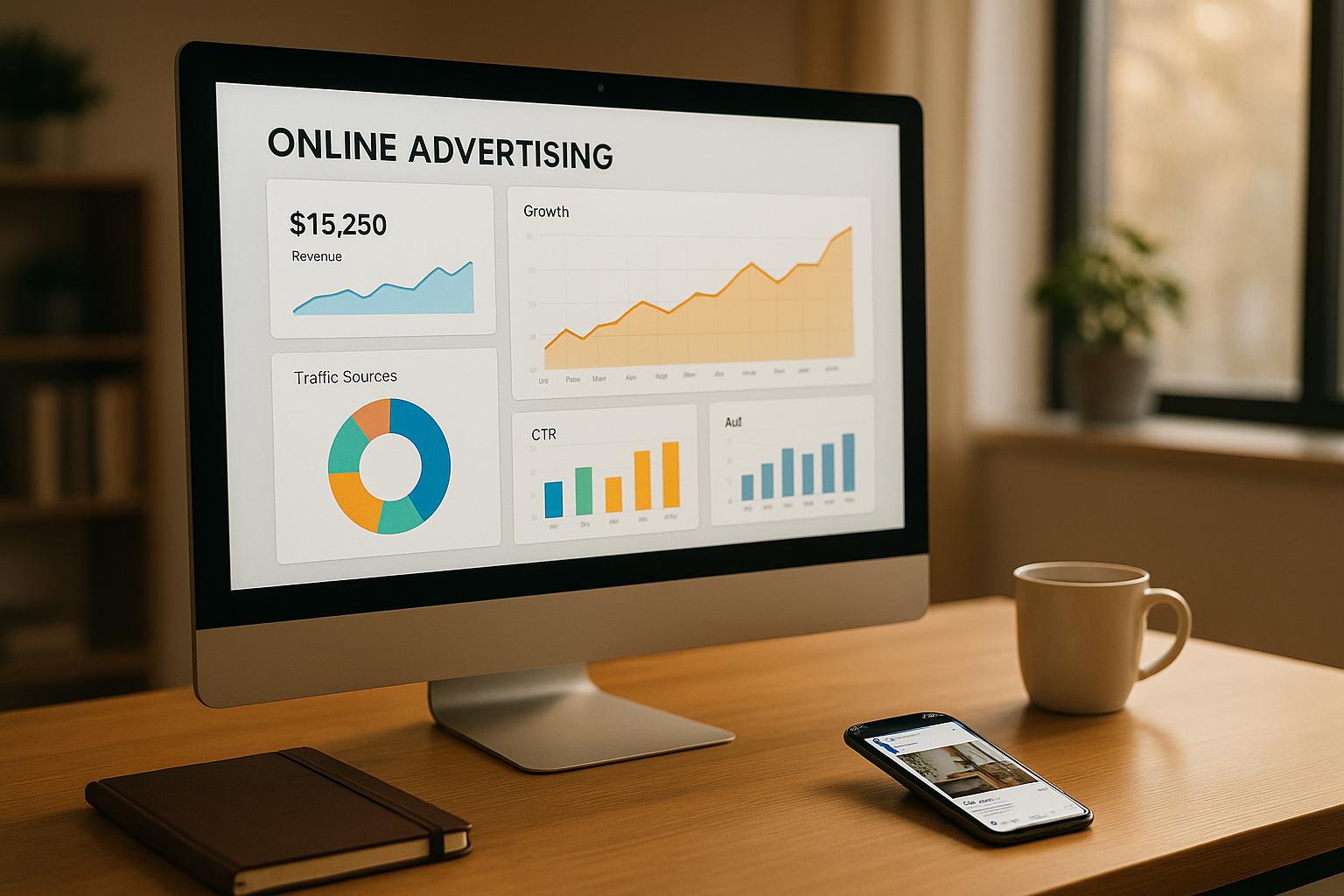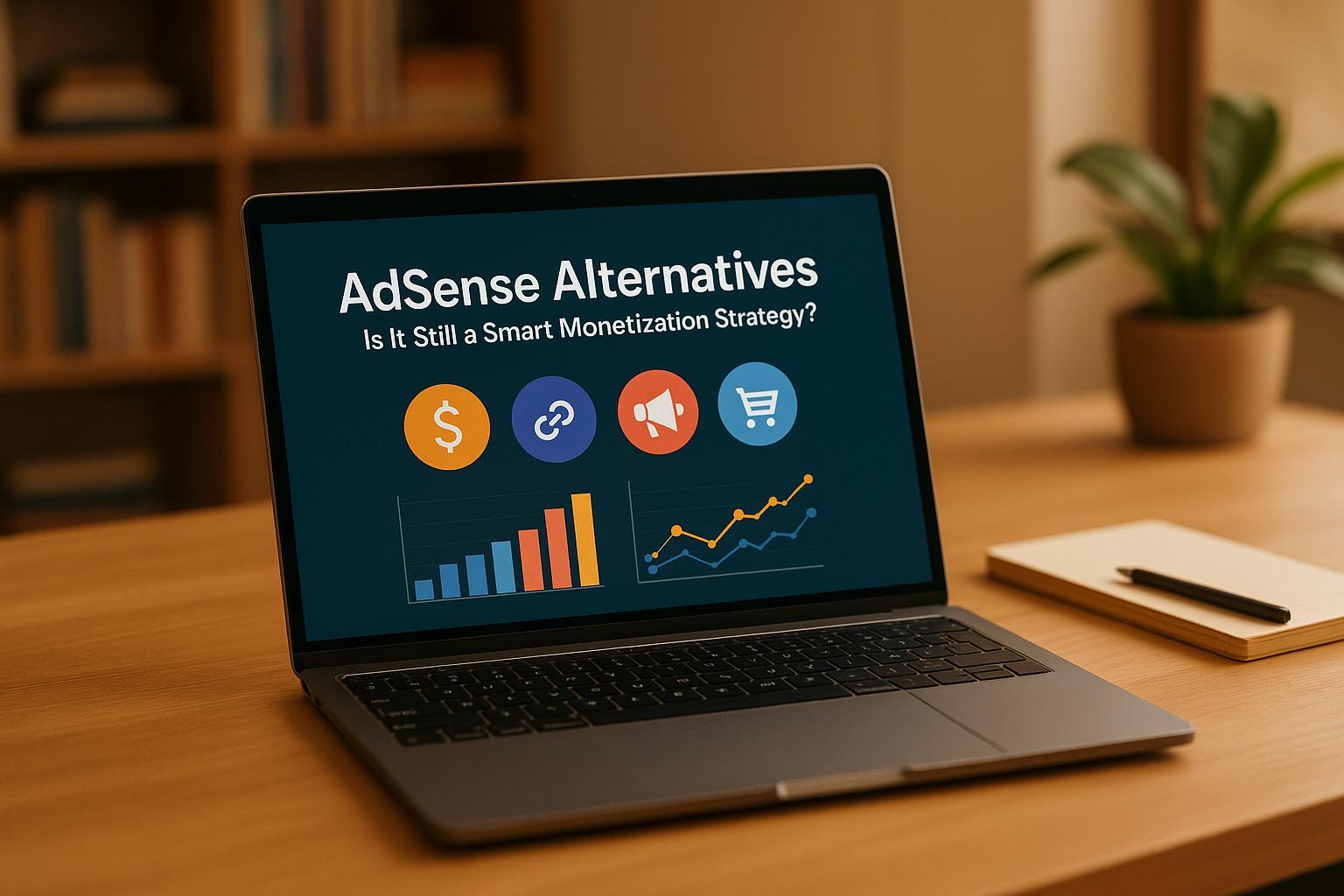Relying solely on Google Ads for revenue is risky. With Google controlling 80% of the small publisher ad market and taking 30% of programmatic revenue, many niche publishers are struggling. Algorithm updates, like those in March/April 2024, have caused traffic drops of up to 90%, leaving publishers vulnerable.
Diversifying with alternative ad networks can reduce this risk and open up new revenue streams. Here’s a quick look at some options:
- TinyAdz: No traffic minimums; ideal for small sites with flexible ad formats like newsletters and social media monetization.
- Microsoft Advertising: Lower CPCs (42% less than Google); great for B2B with LinkedIn targeting and multimedia ads.
- Amazon Ads: High-intent audience; excellent for product-driven content with a 4.5x average ROAS.
- Meta (Facebook & Instagram): Massive reach, low CPCs (~$0.20–$2.00), and strong visual ad options.
- Taboola & Outbrain: Native ad platforms for content-driven monetization; require higher traffic but offer strong engagement.
- Media.net: Contextual ads for quality content sites, with CPMs averaging $1–$5.
Quick Comparison
| Platform | Avg. CPC | Traffic Requirement | Best For | Payment Threshold |
|---|---|---|---|---|
| TinyAdz | Varies | None | Small publishers | No minimum |
| Microsoft Ads | ~$1.54 | None | B2B, professional audiences | Flexible |
| Amazon Ads | ~$0.79–$1.20 | None | Product-focused content | $1 credit limit |
| Meta Ads | ~$0.20–$2.00 | None | Visual, younger audiences | Varies |
| Taboola | ~$0.10 | 500,000 monthly page views | Content engagement | Varies |
| Outbrain | ~$0.10 | None | Native content promotion | Varies |
| Media.net | $1–$5 CPM | Quality content sites | Contextual targeting | $100 |
Takeaway: Test multiple platforms to find the best fit for your audience and content. Combining options like TinyAdz, Meta, and Amazon Ads can reduce reliance on Google while maximizing revenue potential.
8 Google Ads Alternatives - PPC Advertising Networks That Are Worth Testing
1. TinyAdz
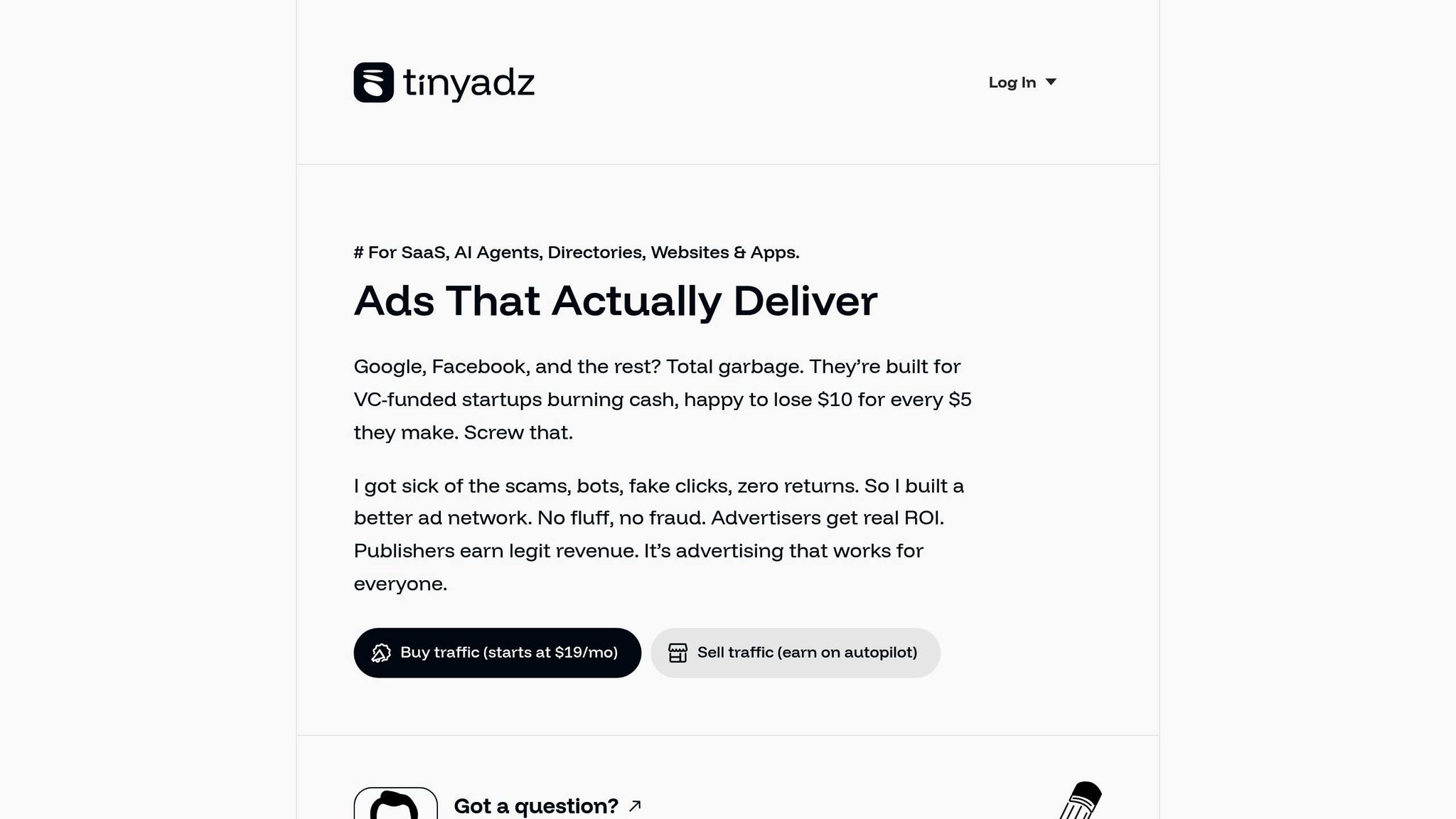
TinyAdz is tailored for niche publishers and small websites, offering a way to start monetizing immediately - no need for heavy traffic to get started.
Minimum Traffic Requirements
One standout feature of TinyAdz is that it doesn’t require publishers to meet any minimum traffic threshold. Unlike many ad networks that demand thousands of monthly visitors, TinyAdz is open to small blogs, emerging newsletters, and community-driven sites from day one.
Ad Formats
TinyAdz provides a variety of monetization options, going beyond the usual display ads. Here’s what publishers can tap into:
- Banner Ads: Designed specifically to resonate with niche audiences.
- Directory Monetization: Turns resource pages and link directories into revenue-generating assets.
- All-Site Traffic Solutions: Monetizes every section of a website, even spaces that might typically go unused.
- Social Media Monetization: Expands earning opportunities to social platforms.
- Newsletter Revenue: Leverages email subscriber lists for additional income.
- Event Monetization: Opens up revenue streams for webinars, conferences, and community events.
As TinyAdz puts it:
"Choose the formats and campaigns that fit you best."
Payout Structure
With a quick setup process and a user-friendly dashboard, TinyAdz ensures publishers can get started smoothly. While exact payout percentages aren’t disclosed, the platform emphasizes clear and transparent reporting, allowing users to track their earnings with ease.
Audience Targeting
TinyAdz takes a simple yet effective approach to audience targeting. Instead of relying on overly complex systems, it focuses on personalized matches between advertisers and publishers, ensuring campaigns align with niche audiences. The platform prioritizes verified traffic and genuine engagement, giving advertisers access to active communities while letting publishers maintain control over the ads displayed on their sites.
Key Strengths
TinyAdz stands out by making monetization accessible to smaller publishers and offering flexible ad formats. Its personalized approach is particularly appealing to niche content creators looking for tailored solutions.
Next, we’ll dive into how Microsoft Advertising transforms monetization for niche publishers.
2. Microsoft Advertising (Bing)
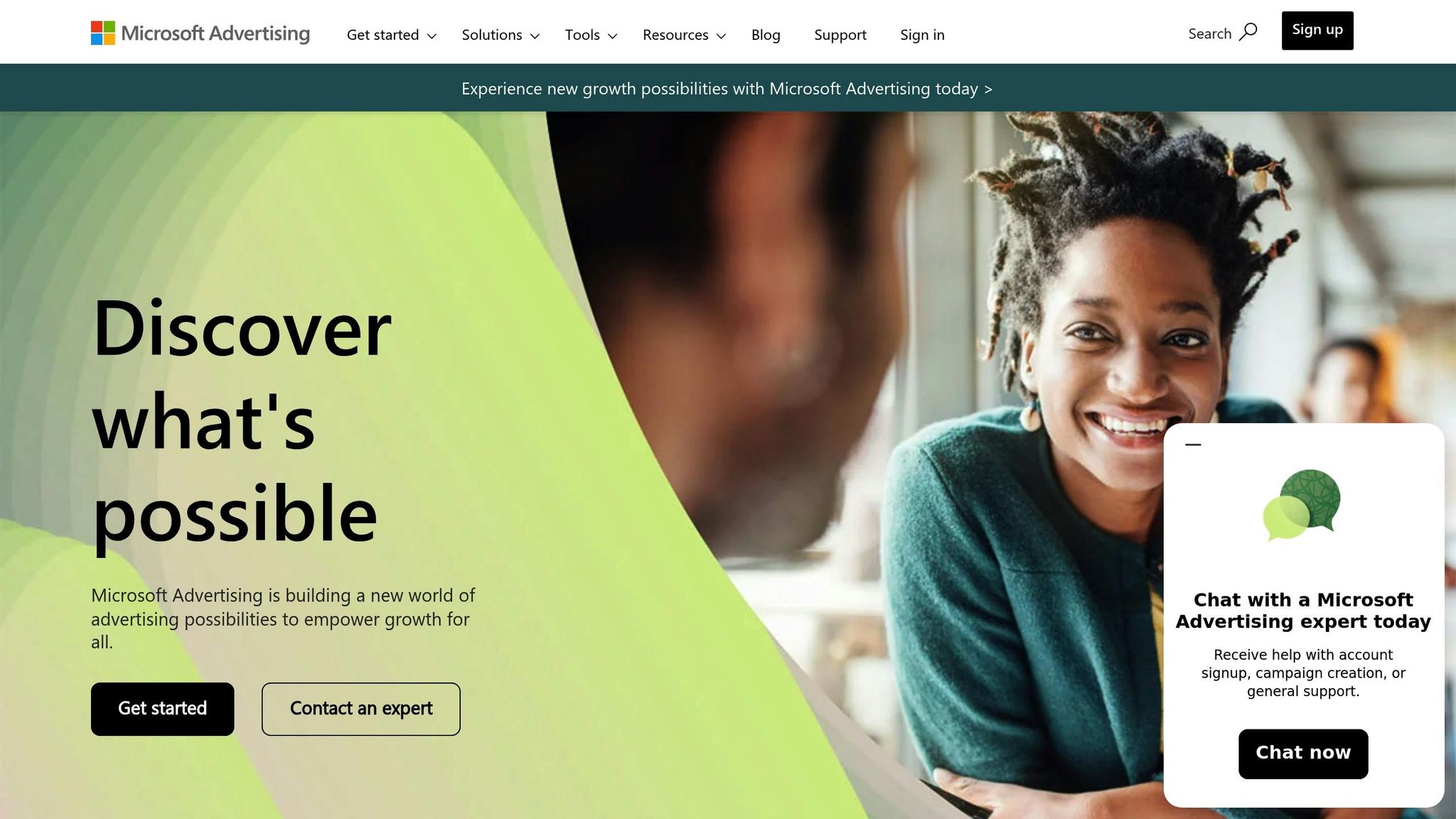
Microsoft Advertising, previously known as Bing Ads, offers an alternative monetization option tailored for niche publishers. While it doesn’t boast the same massive reach as its primary competitor, it provides unique advantages that can yield strong results for the right audience.
Ad Formats
Microsoft Advertising supports a variety of ad formats, designed to cater to different needs, especially for niche publishers:
- Responsive Search Ads: These ads test multiple combinations of headlines and descriptions automatically, making them perfect for publishers who may lack the resources for detailed A/B testing.
- Microsoft Audience Ads: By targeting users based on demographics, interests, and behaviors, these ads are excellent for reaching specific, well-defined audience segments.
- Multimedia Ads: These visually rich ads stand out, delivering a 60% higher click-through rate compared to traditional search ads. They’re especially effective for visually driven niches like home decor, fashion, or travel.
- Dynamic Search Ads: These ads automatically match relevant search queries to your website content, making them ideal for publishers with content-heavy sites.
These options create a strong foundation for precise audience targeting and engagement.
"Search campaigns deliver the most direct path from query to conversion, particularly for advertisers who want to target high-intent audiences effectively."
– Jonathan Eig, Product Marketing Manager, Microsoft Advertising
Audience Targeting
One of Microsoft Advertising's standout features is its integration with LinkedIn profile targeting - something no other major platform offers. This feature allows B2B publishers to reach users based on professional attributes like job title and company size. In addition, the platform provides extensive targeting options, including demographics, location, device type, and time-based segmentation. These tools make it easier to connect with the right audience at the right time.
Payout Structure
Microsoft Advertising uses a cost-per-click (CPC) model, with an average CPC that’s about 42% lower than Google Ads. This reduced competition can result in better returns for publishers. Despite its smaller market share, the platform still sees approximately 13.9 billion searches monthly and 100 million daily active users, offering significant monetization opportunities.
Key Strengths and Limitations
Microsoft Advertising boasts a 34% higher click-through rate compared to Google Ads, and its user base includes individuals who spend more online than the average internet user - 32% of them, to be exact. The audience skews toward valuable demographics, with 25.74% aged 25–34 and 23.39% aged 35–44. Additionally, 44 million desktop users rely exclusively on Bing for their searches, representing an untapped opportunity for many publishers.
However, Microsoft Advertising holds only 4% of the global search engine market share. That figure rises to 17.55% for desktop searches in the United States, but the smaller overall reach can be a limitation. On the flip side, this reduced competition often means lower costs and better efficiency for advertisers. The platform’s revenue grew by 13.4% from 2024 to 2025, with expectations of a 12.2% increase in 2026, potentially reaching $19.53 billion. Its seamless integration with Microsoft products like Windows and Office further expands its influence in professional settings, making it particularly appealing for B2B publishers.
For niche publishers looking for cost-effective advertising with precise targeting, Microsoft Advertising offers a compelling option.
3. Amazon Ads

Amazon Ads provides niche publishers with a unique opportunity to tap into Amazon's enormous customer base. Unlike traditional search ads, Amazon focuses on users who are already in a buying mindset. This makes it an excellent choice for publishers with product-driven content or affiliate marketing strategies.
Ad Formats
Amazon offers a variety of ad formats tailored to different marketing objectives:
- Sponsored Products: These ads promote individual items within search results and on product pages, driving direct sales.
- Sponsored Brands: These ads showcase your brand logo, a custom headline, and multiple products at the top of search results, helping to build brand recognition.
- Sponsored Display: These ads extend your reach by targeting audiences on Amazon-owned sites and external websites.
Additionally, Amazon DSP (Demand-Side Platform) enables advanced video and audio advertising. With Prime Video's ad-supported audience exceeding 130 million monthly viewers in the U.S., advertisers can connect with a massive audience. Notably, 88% of Prime Video viewers also shop on Amazon, creating a seamless link between entertainment and shopping.
"We're connecting with these customers sun-up to sundown, through the content they obsess over, and the services that make their lives easier, and the products they need and want. With Amazon you get it all - you buy into one powerful, interconnected community fueled with trillions of insights."
– Tanner Elton, Vice President of U.S. Ad Sales
Audience Targeting
Amazon's audience targeting goes far beyond basic demographics. By leveraging its first-party shopping data, the platform allows advertisers to create highly specific audience segments. For example, you can target customers who have interacted with your brand, build lookalike audiences based on your current customers, or reach users browsing similar products.
Sponsored Display ads work similarly to remarketing, letting you reconnect with shoppers who have viewed your product listings or target those interested in related items. Amazon DSP takes this a step further, combining demographic and behavioral data to drive results. Campaigns using Amazon DSP have shown up to a 30% increase in ad recall and a 20% boost in brand lift compared to less targeted campaigns.
For niche publishers, this level of precision is invaluable. You can start by setting clear campaign goals, then use data from previous campaigns and customer analytics to refine your audience. Amazon recommends beginning with broader segments and narrowing them based on performance insights.
Payout Structure
Amazon Ads operate on a cost-per-click (CPC) model, with average monthly costs in the U.S. ranging between $0.79 and $1.20. For new advertisers, starting with a daily budget of $5–$10 and keyword bids of $0.21–$0.25 is a practical way to test performance.
The potential returns are impressive. High-performing Amazon ads boast a conversion rate of about 36%. For instance, spending $260 on ads can yield approximately $900 in sales. On average, Amazon sellers achieve a 4.5x return on ad spend (ROAS), meaning every $1 invested generates $4.50 in revenue. In fact, Amazon ads often deliver a 20% higher ROI compared to a brand's typical marketing efforts.
Key Strengths and Limitations
Amazon's standout advantage lies in its high-intent audience. Shoppers on Amazon are there to purchase, not just browse, which translates to a measurable impact on sales. Additionally, Amazon Ads tend to cost less than Google or Facebook Ads while delivering better results in terms of actual sales.
Its targeting capabilities also set it apart. While many platforms offer basic demographic targeting, Amazon DSP uses first-party data to create advanced audience segments, enabling custom targeting and real-time optimization. The average shopper takes six to seven days to make a purchase after their initial search, giving advertisers multiple chances to influence their decision.
However, Amazon Ads are best suited for publishers with product-focused content or strong affiliate marketing strategies. Publishers relying solely on display ads may find the platform less effective. Success also requires consistent testing and optimization, making it more hands-on compared to some alternatives.
| Feature | Amazon Ads | Amazon DSP |
|---|---|---|
| Traffic Source | Amazon marketplace users | Amazon-owned sites + external websites |
| Audience Targeting | Keywords, competitor ASINs, categories | First-party Amazon data, behavioral targeting |
| Ad Formats | Sponsored Products, Sponsored Brands, Sponsored Display | Display, Video, Audio Ads |
| Cost Model | CPC-based bidding and vCPM | Cost+Fees model and CPM-based bidding |
| Best Use Cases | High-intent sales | Retargeting and brand growth |
For publishers looking to move beyond traditional display ads, Amazon Ads offers a powerful way to monetize through commerce-driven advertising.
Next, we’ll dive into how Facebook and Instagram Ads (Meta) can further expand your monetization options.
4. Facebook & Instagram Ads (Meta)
For niche publishers exploring options beyond Google Ads, Meta offers a powerful way to expand audience engagement. By combining Facebook's massive daily user base of approximately 3.065 billion people with Instagram's visually driven platform that resonates with younger audiences, Meta creates a dynamic advertising ecosystem.
Ad Formats
Meta's ad options are impressively diverse, covering formats like image ads, video ads, carousel ads, collection ads, stories, reels, playable ads, and instant experience ads. These can be displayed across Facebook, Instagram, Messenger, and the Audience Network. Video ads, in particular, stand out by generating 49% more engagement than static formats. Plus, Meta's Advantage+ campaigns simplify the process by automatically optimizing ad placements. Targeted ads on Meta can achieve up to 5.3 times higher click-through rates, and around 37% of social media users make purchases influenced by these ads. This extensive format variety, paired with precise targeting, makes Meta a standout advertising platform.
Audience Targeting
Meta's targeting capabilities go beyond traditional keyword-based methods. Instead, it focuses on segmenting audiences based on interests and behaviors. Instagram, for instance, is especially popular among users aged 18–34, with significant activity from both genders. Tools like lookalike audiences allow advertisers to connect with people similar to their existing customers, sharpening the precision of campaigns.
"Facebook ads are typically about pushing products/services in front of potential customers who aren't actively looking for a solution. Google, on the other hand, is most often used to get ads in front of users who are actively searching for your products/services. Due to this, Facebook is often better for new products/services that don't have existing demand, while Google is more useful for convincing existing demand to purchase from your business rather than the competition."
– Josh Sexton, Digital Performance Director, Sprocket Digital
Payout Structure
Meta's pricing structure is competitive but varies between platforms. On Facebook, the average cost per click (CPC) is $0.77, with a CPM (cost per thousand impressions) of $8.77. Instagram ads, on the other hand, range from $0.20 to $2.00 per click, with a CPM averaging $6.70. Notably, 95% of Facebook ads are viewed on mobile devices, and Instagram offers access to 450 million users who aren't on Facebook, giving advertisers the opportunity to reach unique audiences.
| Platform | Average CPC | Average CPM | Best For |
|---|---|---|---|
| $0.77 | $8.77 | Broad demographics; detailed targeting | |
| $0.20–$2.00 | $6.70 | Visual content; younger audiences | |
| Combined Meta | Varies | Varies | Maximum reach across diverse age groups |
Key Strengths and Limitations
Meta's biggest advantage is its unparalleled reach and ability to target audiences with precision. With 80% of global internet users engaging with Facebook and nearly 90% of marketers using the platform, it offers an enormous potential audience. Its creative ad formats, especially on Instagram, allow for visually compelling campaigns that stand out. Instagram excels in storytelling and aesthetic appeal, while Facebook supports a broader range of content types. Additionally, Meta's advanced conversion tracking tools help advertisers measure user actions after ad exposure.
However, Meta advertising has its hurdles. High competition among advertisers can drive up costs, especially in crowded niches. Campaigns often require ongoing optimization, and factors like ad blockers and limited reach among older demographics can pose challenges.
"Facebook is ideal for detailed targeting and broader reach, while Instagram excels in visual engagement and reaching younger demographics."
– Christie Patrick, Facebook Ads Ace
For niche publishers, Meta's real strength lies in connecting with audiences who may not be actively searching for content but can become highly engaged when they encounter it. This approach complements search-based strategies, providing a pathway to diversify and expand monetization efforts.
Next, we'll delve into how Taboola's content discovery platform can further enhance your monetization strategy.
5. Taboola
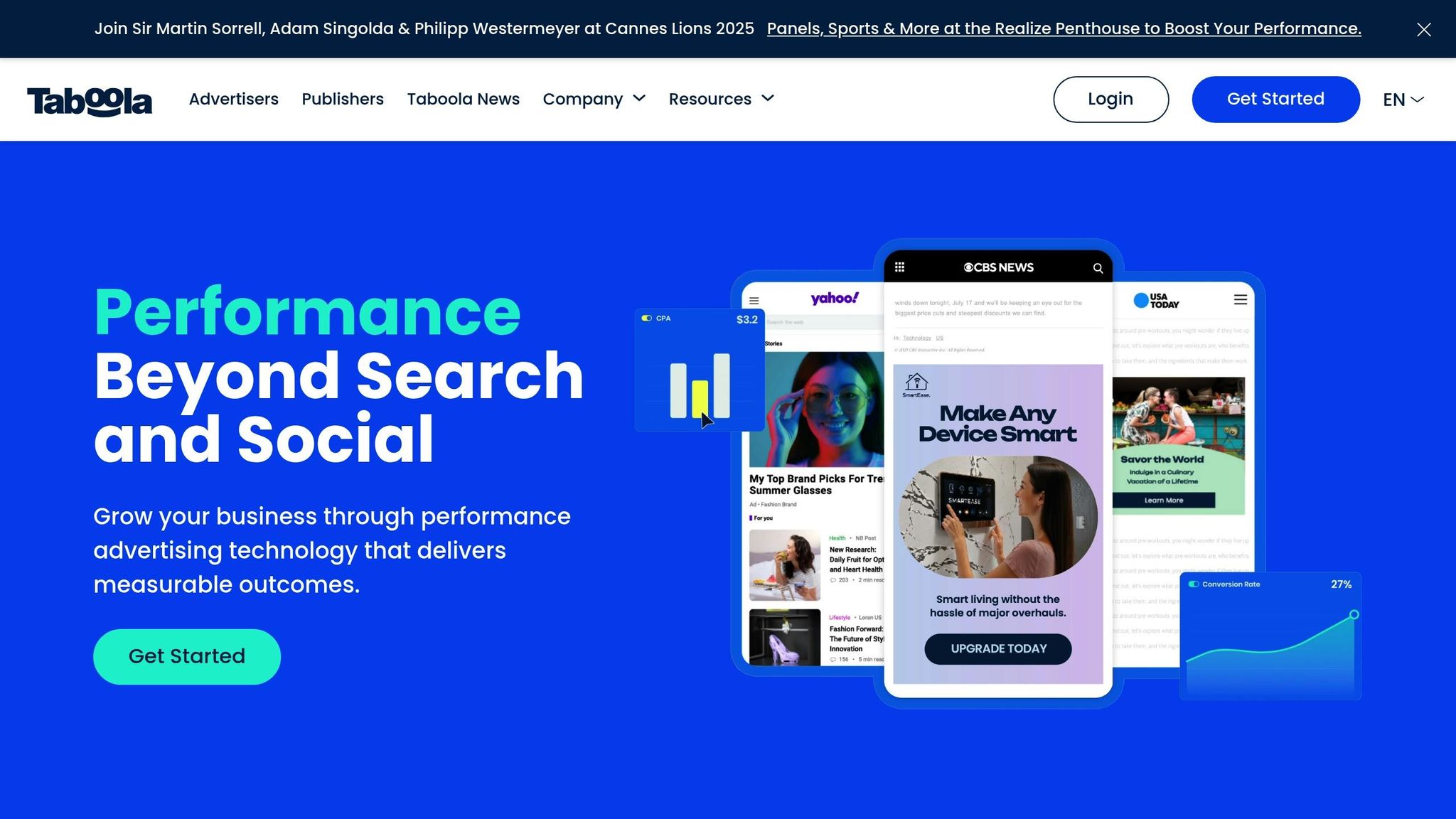
Taboola is a content discovery platform that delivers native ads through sponsored content recommendations. Unlike search-based advertising platforms, Taboola uses a predictive engine to serve ads based on user interests, behaviors, and engagement history. This makes it a strong option for publishers who want to monetize their sites with content-driven advertising strategies. Taboola also expands monetization opportunities by offering content-based native advertising, providing publishers with additional ways to diversify their revenue streams.
Minimum Traffic Requirements
To join Taboola’s publisher network, your site must have at least 500,000 monthly page views. While this threshold may seem high, it creates an opportunity for niche publishers who are steadily growing their audience to tap into a lucrative advertising network.
Ad Formats
Taboola specializes in native ad formats, including sponsored content recommendations, app promotion ads, and motion ads. These ads are seamlessly integrated into websites, appearing as in-feed content within articles or as recommendation widgets alongside organic content. Many publishers have reported noticeable improvements in revenue per mille (RPM), click-through rates (CTR), and overall audience engagement after adopting Taboola's native ad solutions.
Audience Targeting
Taboola leverages both first-party and third-party data for audience targeting. It offers retargeting, lookalike audiences, and contextual segmentation, while also allowing advertisers to target users based on time, device type, location, and interests. However, compared to keyword-focused platforms like Google Ads, Taboola’s targeting options are somewhat less detailed.
Payout Structure
Taboola employs a 50% revenue share model with publishers, issuing payments 45 days after the end of each month. For U.S.-based publishers, payments are processed through Payoneer without additional transfer fees. Revenue potential depends heavily on traffic quality and geographic location. For example, high-quality traffic can achieve RPM rates of $2 or more. Some publishers have reported click-through rates nearing 1%, with cost-per-click (CPC) rates of 4 to 5 cents and RPMs around $0.40.
Key Strengths and Limitations
One of Taboola’s standout features is its native advertising model, which often results in higher engagement compared to traditional display ads. However, this approach isn’t without its drawbacks. Clickbait-style content and occasional lower-quality ad placements can pose challenges. Additionally, ads sometimes appear on less reputable sites, and the platform’s reporting tools may not offer the same level of transparency as more established networks. For niche publishers, placing sponsored content units below articles and filtering out undesirable words or phrases in headlines can help maintain the quality and credibility of their content.
sbb-itb-957fd63
6. Outbrain

Outbrain is a native advertising platform designed to connect consumers with brands through content recommendations. It works across thousands of publisher sites, offering tools for automated ad creation and advanced targeting to help publishers diversify their revenue streams.
Minimum Traffic Requirements
Unlike some platforms, Outbrain doesn’t enforce a strict minimum traffic requirement for publishers. Instead, it prioritizes partnerships with established websites in categories like news, sports, and entertainment to maintain the quality of its network.
Ad Formats
Outbrain provides four main ad formats: Standard Native, Clip, App Install, and Carousel. These ads blend seamlessly into publisher content, appearing as recommended articles or sponsored widgets. Native ads on the platform have been shown to deliver impressive results, such as 20%-60% higher engagement, 53% more views, and an 18% increase in purchase intent. For added convenience, Outbrain can automatically generate ads from provided URLs, making it easier for publishers to adopt native advertising.
Audience Targeting
Outbrain offers a range of targeting options, including placement, standard, advanced audience, contextual, and dynamic retargeting. Publishers have access to detailed controls, such as location, device type, and audience segmentation settings. The platform also supports A/B testing, allowing users to fine-tune campaigns for better results. Its targeting system leverages user interests, behaviors, and contextual signals, providing a level of specificity that stands out among native advertising platforms. This precise targeting pairs well with the platform’s performance-based PPC model.
Payout Structure
Outbrain operates on a pay-per-click (PPC) basis, meaning advertisers are charged only when users engage with their ads. Campaigns require a minimum daily budget of $20, though most fall between $50 and $500 per day, depending on goals. Cost-per-click rates are influenced by factors like audience size, targeting settings, and competition, with Outbrain often offering lower CPC rates compared to similar platforms.
Key Strengths and Limitations
Outbrain boasts several strengths, including its well-known brand, advanced machine learning for personalized recommendations, and a diverse network of publishers that helps advertisers reach broader audiences. Its performance-based model aligns the interests of publishers and advertisers, while automated tools simplify the ad creation process.
However, there are some challenges to consider. Outbrain’s reliance on publisher partnerships can create dependency risks, and the crowded content recommendation market increases competition. Additionally, limited control over content quality means ads may occasionally appear on less-than-ideal sites, requiring ongoing monitoring.
For niche publishers looking to expand their monetization options, Outbrain offers a flexible and effective solution.
7. Media.net

Media.net is a contextual advertising platform designed to deliver ads that align closely with website content. By analyzing the content on a site and matching it with advertiser keywords, Media.net offers publishers an opportunity to generate revenue through targeted ads. Let’s take a closer look at what makes Media.net stand out.
Minimum Traffic Requirements
Unlike some advertising networks, Media.net doesn’t publicly share specific traffic thresholds for approval. Instead, they focus on the quality of the website and its audience. Sites with traffic from Tier 1 countries like the United States, United Kingdom, and Canada are more likely to be approved. This makes it a good option for niche publishers with smaller but highly engaged audiences. To ensure ad quality, Media.net uses proprietary tools, third-party partnerships, and manual reviews to monitor inventory.
Ad Formats
Media.net offers a variety of ad formats, including contextual display ads and native ad units that blend seamlessly into website content. By using contextual targeting, the platform ensures that ads match the content of the page, resulting in banner ads, text links, or content recommendation widgets that feel relevant to users and encourage engagement.
Audience Targeting
Media.net’s targeting strategy is rooted in contextual technology rather than behavioral tracking. By analyzing the themes, keywords, and signals within a page’s content, the platform delivers ads that are contextually relevant. This approach allows for precise targeting, especially when publishers maintain well-structured, high-quality content. Compared to some competitors, this method gives publishers more control over the relevance of the ads displayed on their sites.
Payout Structure
Media.net operates on a cost-per-click (CPC) model, meaning publishers earn revenue when users click on ads. Payments are processed on a NET 30 basis, so earnings are distributed 30 days after the month in which they’re earned. To receive payment, publishers must meet a $100 minimum threshold. Payment options include Payoneer and wire transfer, but PayPal is no longer supported. Payoneer transfers come with a small fee of $1.50.
Earnings depend heavily on content quality and audience location. On average, Media.net pays between $1 and $5 per 1,000 views (CPM). However, some publishers have reported higher earnings. For instance, one case study highlighted RPM (revenue per thousand impressions) peaking at $20 on certain days, with averages ranging between $5 and $10 depending on the niche.
Strengths and Limitations
Media.net shines with its contextual ad targeting and emphasis on rewarding quality content. However, its selective approval process and the lack of clarity around traffic requirements can be hurdles for some publishers. To maximize earnings, publishers should focus on creating keyword-rich, high-quality content and aim to attract a significant portion of their audience from Tier 1 countries.
Platform Comparison
When choosing an advertising platform, it’s essential to weigh factors like audience targeting, cost structure, and payment requirements to make the most of your monetization efforts.
Audience Targeting Capabilities
Microsoft Advertising stands out with its LinkedIn profile targeting, allowing advertisers to reach users based on job title, company, or industry. This, combined with remarketing lists, can boost conversion rates by up to 50%.
Meta Ads offers robust demographic, interest, and behavioral targeting tools. However, privacy regulations have slightly reduced the effectiveness of its detailed targeting. The platform shines in custom audience and lookalike targeting strategies, delivering a 60% lower average cost-per-acquisition for B2C campaigns compared to Google Search Ads.
Amazon Ads taps into proprietary shopping data to offer highly precise targeting.
Each platform has its strengths, but understanding their cost structures and competition is equally important.
Cost Structure and Competition
Microsoft Advertising offers a cost advantage, with CPCs averaging 35% lower than Google Ads, while still capturing over 36% of the U.S. desktop search market.
"Microsoft Advertising taps into a premium audience across multiple touchpoints, driving higher engagement at a lower cost."
For native advertising, platforms like Taboola and Outbrain are budget-friendly, with average CPCs ranging from a few cents to about $0.10. These platforms provide affordable options while maintaining partnerships with quality publishers.
Payment Methods and Requirements
Payment models and thresholds vary across platforms, offering flexibility for different needs:
- TinyAdz: No minimum traffic requirement, making it accessible to smaller publishers.
- Media.net: Focuses on quality audiences from the U.S., U.K., and Canada, with a $100 minimum payout threshold.
- Amazon Ads: Uses a credit limit system starting at $1, which increases with successful payment history, and accepts multiple payment methods like credit cards, debit cards, and seller account charges.
- Microsoft Advertising: Offers flexible payment options, including prepay, postpay, and monthly invoicing.
- Taboola: Accepts wire transfers, ACH, SEPA, checks, and credit cards but charges processing fees of 2.5% to 3.5% for credit card payments.
Here’s a quick comparison to help visualize the differences:
| Platform | Average CPC | Key Targeting Strength | Payment Threshold | Best For |
|---|---|---|---|---|
| TinyAdz | Varies | Niche audience matching | No minimum | Small to medium publishers |
| Microsoft Advertising | $1.54 | LinkedIn professional data | Flexible options | B2B and premium demographics |
| Amazon Ads | Varies | Purchase intent signals | $1 credit limit | E-commerce and CPG brands |
| Meta Ads | $1.72 | Demographic/behavioral | Varies | B2C and visually engaging products |
| Taboola | Few cents | Content recommendation | Varies | Content-driven engagement |
| Outbrain | $0.10 | Interest-based targeting | Varies | Native content promotion |
| Media.net | $1–5 CPM | Contextual content matching | $100 minimum | Quality content sites |
Demographic Considerations
Each platform caters to different audience profiles:
- Microsoft Advertising targets a mature, affluent audience, with 70% of users aged 35 or older.
- Meta Ads performs well with younger audiences and visually engaging content.
- LinkedIn offers access to premium, professional users but comes with higher CPCs and CPMs.
- Taboola and Outbrain focus on content engagement, making them effective across diverse age groups.
For publishers, the choice depends on your audience and content focus. Platforms like Microsoft Advertising and LinkedIn are ideal for professional or business-related content, while Meta Ads and native networks like Taboola and Outbrain are better suited for lifestyle and consumer-oriented campaigns. TinyAdz, with its open-access model, can complement these platforms for broader monetization strategies.
Conclusion
Expanding beyond Google Ads is a smart way to boost revenue and reduce reliance on a single platform. By understanding the strengths of various advertising platforms, publishers can make informed decisions and build a more resilient monetization strategy.
Each platform has its own appeal: Microsoft Advertising excels at reaching professional audiences, Amazon Ads boasts high conversion rates, and Meta provides unparalleled access to a massive consumer base. These platforms have proven their worth with strong performance metrics tailored to different goals.
Start by running small test campaigns across several platforms to see which ones resonate with your audience. Tailor your choices to your audience demographics. For instance, LinkedIn targeting through Microsoft Advertising is ideal for business-focused campaigns, while native advertising platforms like Taboola and Outbrain are great for lifestyle or entertainment content. This approach lays the groundwork for a well-rounded and diversified revenue model.
"Choosing the right ad network requires evaluating revenue models, ad formats, integration, and compliance".
Don't forget to weigh factors like payment thresholds, approval times, and technical requirements alongside potential earnings. For smaller publishers, platforms like TinyAdz - offering no minimum traffic requirements - are a good starting point. Larger, more established sites can explore premium networks like Media.net or Amazon Ads to further enhance their earnings. By combining multiple platforms, publishers can safeguard against market shifts and algorithm updates, ensuring steady and reliable revenue streams.
With global ad spending continuing to grow, there's no shortage of opportunities across various networks. Publishers who diversify their ad revenue sources and embrace a strategic approach will be better positioned to thrive in an ever-changing digital landscape.
FAQs
What are the benefits of using alternative ad networks instead of Google Ads for niche publishers?
Why Consider Alternative Ad Networks?
Alternative ad networks can bring some distinct benefits for niche publishers aiming to boost their monetization strategies. These platforms often come with lower cost-per-click (CPC) rates, adaptable ad formats, and targeting options tailored to specific audiences. This combination can lead to improved ad performance and a more engaging experience for users.
Another advantage is that these networks often have easier approval processes. They also allow publishers to diversify their revenue streams, reducing the risk of depending entirely on one platform. For niche publishers, this means the ability to deliver ads that connect more effectively with their audience, all while maintaining transparency and addressing issues like fake traffic.
How can small publishers with low traffic monetize their content using TinyAdz?
Small publishers who don't have massive traffic can still make money from their content with TinyAdz. This platform specializes in delivering hyper-targeted ads that align with niche audiences. The beauty of this approach? It doesn’t rely on high visitor numbers to generate revenue.
By focusing on specialized content and fine-tuning ad placement, publishers can attract better-paying ads while keeping their audience engaged. TinyAdz offers tools that ensure the ads align perfectly with your content, improving both the user experience and your earnings. With a combination of targeted advertising and diversified income streams, even smaller publishers can achieve impressive results.
What should publishers look for when choosing an ad network to increase and diversify their revenue?
When choosing an ad network, it's essential to weigh factors like audience targeting options, variety of ad formats, and clear reporting tools. These aspects ensure the network complements your content and helps you get the most out of your monetization efforts.
You should also look into the network's revenue share structure, minimum payout limits, and compatibility with different devices. Another critical point is assessing how well the network's audience reach aligns with your niche. This alignment is key to engaging users effectively and driving meaningful results. Partnering with the right ad network can increase your earnings while keeping the user experience smooth and uninterrupted.

